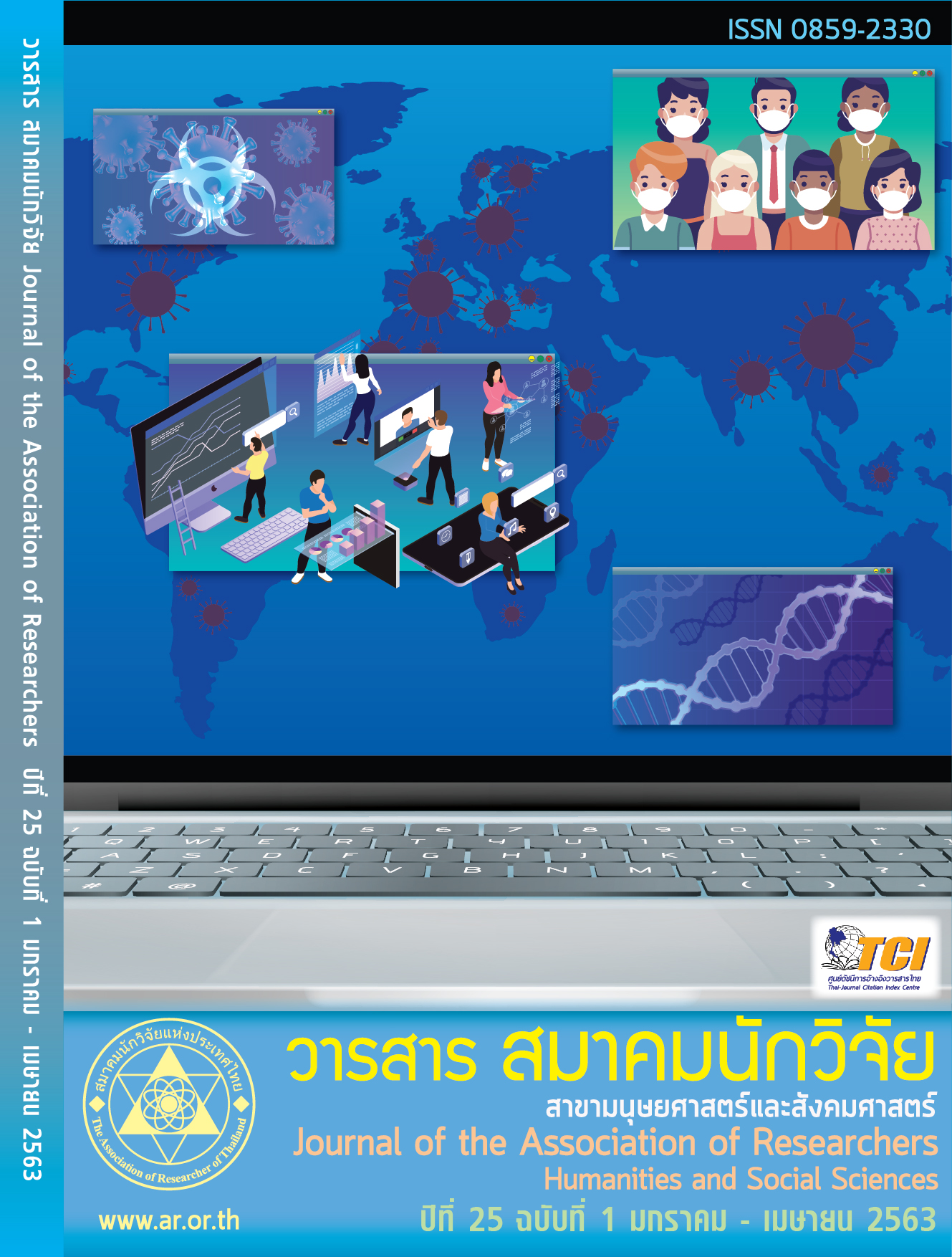The Success in Sustainable Environmentally Friendly Products Managementfor Industrial plants
Main Article Content
Abstract
There are three purposes of this research. The first is to study the levels of the success in sustainable environmentally friendly products management for industrial plants, green innovation strategy, corporate social responsibility, government policy, transformation leadership and human resource development. The second is to examine the influences of green innovation strategies, corporate social responsibility, government policy, transformation leadership and human resource development on the success in sustainable environmentally friendly products management. The third is to assess the guidelines for environmentally friendly products management. This study consists of quantitative and qualitative research. The quantitative research respondents are 400 managers working in plants in Samutprakarn and Samut sakhon provinces. Using multistage random sampling. The data were collected from questionnaires and analysis by a structural equation model. The qualitative research was performed via a content analysis in-depth interviews with 15 managers by specific selection and analysis the data to guideline for environmentally friendly products management. Findings indicated that 1) corporate social responsibility is at its highest level, followed by transformational leadership, green innovation strategy, human resource development, government policies, and the success in sustainable environmentally friendly products management. All of them had a high level of opinion. 2) the success in sustainable environmentally friendly products management is affected by human resource development, corporate social responsibility, transformational leadership, green innovation strategy and government policy, respectively and 3) the success in sustainable environmentally friendly products management guidelines, Executives should have a vision to focus on human resource development, ethics to be aware of social responsibility and manufacturing products comply with government’s policies. The finding will be help to succeed in sustainable environmentally friendly products management for industrial plants.
Article Details
บทความที่ปรากฏในวารสารนี้ เป็นความรับผิดชอบของผู้เขียน ซึ่งสมาคมนักวิจัยไม่จำเป็นต้องเห็นด้วยเสมอไป การนำเสนอผลงานวิจัยและบทความในวารสารนี้ไปเผยแพร่สามารถกระทำได้ โดยระบุแหล่งอ้างอิงจาก "วารสารสมาคมนักวิจัย"
References
ชาย โพธิสิตา (2554) ศาสตร์และศิลป์แห่งการวิจัยเชิงคุณภาพ พิมพ์ครั้งที่ 5 กรุงเทพฯ อมรินทร์พริ้นติ้งแอนด์พับลิชชิ่ง
นวัตกรรมสีเขียวอุตสาหกรรมเป็นมิตรสิ่งแวดล้อม (2561) สืบค้นเมื่อ พฤษภาคม 30, 2562 , จาก www.prachachat.net
สำนักงานคณะกรรมการพัฒนาการเศรษฐกิจและสังคมแห่งชาติ (2560) แผนพัฒนาการเศรษฐกิจและสังคมแห่งชาติ ฉบับที่ 12 พ.ศ. 2560-2564 กรุงเทพฯ: ผู้แต่ง
สำนักงานปลัดกระทรวงอุตสาหกรรม (2560) กรมโรงงานอุตสาหกรรม สืบค้นเมื่อ ธันวาคม 20 ,2561, จาก www.greenindustriy.diw.go.th
สำนักงานปลัดกระทรวงอุตสาหกรรม (2559) แผนยุทธศาสตร์กระทรวงอุตสาหกรรม พ.ศ. 2560-2564 (ฉบับทบทวน) กรุงเทพฯ: กระทรวงอุตสาหกรรม
Avolio, B. J. & Bass, B. M. (2004). Multifactor Leadership Questionnaire: Third Edition Manual. New York: Mind Garden INC
Bartelmus P. (2013). The future we want: Green growth or sustainable development ? Environmental Development , 7, 165-170
Beer, M. (2010). Managing Change and Transition. Harvard: Harvard Business School Publishing.
Carroll, A. B. (1991). The pyramid of corporate social responsibility: Toward the moral management of organizational stakeholders. Business Horizons, 34(4), 39-48.
Chien, S.,Y. & Tsai C., H. (2012). Dynamic capability, knowledge, learning and firm performance. Journal of Organizational Change Management, 25(3), 434 – 444.
Dangelico, R.M., & Pujari, D. (2010). Mainstreaming green product innovation: Why and how companies integrate environmental sustainability. Journal of Business Ethics. 95(3), 471-486
Dubey, Rameshwar, Gunasekaran, A. & Ali, S. S. (2015). Exploring the relationship between leadership, operational practices, institutional pressures and environmental performance :A framework for green supply chain. International Journal of Production Economics 160, 120-132.
Griffith, R., et al.(2006). Innovation and productivity across four European countries. Oxford review of economic policy, 22(4), 483-498.
Hair, J. F., Black, W. C., Babin, B. J. & Anderson, R. E., (2010). Multivariate data analysis (7th ed.). Upper Saddle River, NJ: Prentice Hall.
Marimuthu, M., Arokiasamy, L., & Ismail, M. (2009). Human capital development and its impact on firm performance: Evidence from developmental economics. The Journal of International Social Research, 2(8), 265-272.
Mele’, D. (2008). Corporate social responsibility theories. In Crane, A. (Eds.), The Oxford handbook of corporate social responsibility ( pp.47–82). New York, New York: Oxford University Press.
Mohsen, A. & Mohammad, R.D. (2011). Considering Transformational Leadership Model in Branches of Tehran Social Security Organization. Social and Behavioral Sciences, 15, 3131-3137.
Nalbantian, R., Guzzo, R. A., Kieffer, D. & Doherty, J. (2004). Play to Your Strengths: Managing your internal labour markets for lasting competitive advantage. New York: McGraw-Hill.
Nastasi, B. K. & Schensul, S. L. (2005). Contributions of qualitative research to the validity of intervention research. Journal of School Psychology, 43(3), 177-195.
Roberts, N. & Grover, V.(2012). Investigating firm's customer agility and firm performance: The importance of aligning sense and respond capabilities. Journal of Business Research, 65(5), 579-585.
Sheng, S., Zhou, K.Z. & Lessassy, L. (2013). NPD speed VS. innovativeness :The contingent impact of institutional and market environments, Journal of Business Research, 66 (11), 2355-2362.
Strand, R. (2011). Exploring the Role of Leadership in Corporate Social Responsibility: A Review. Journal of Leadership, Accountabilities, and Ethics, 8(4), 84-96.
TRANSLATED THAI REFERENCES
Phosita, Chai . (2011). The science and art of qualitative research. Bangkok: Thumrin Printing & Publishing Co. (in Thai).
Green Innovation Industry Friendly Environment. (2018). Retrieved May 30, 2562, from.www.prachachat.net. . (in Thai)
Krutka, Chomsupak. (2011). The demand for human resource development to ASEAN community. An academic journal of Applied Arts, 63-67. (in Thai).
Office of the National Economic and Social Development Board. (2017). National Economic and Social Development Plan No. 12. 2017-2021. (in Thai).
Office of Permanent Secretary, Ministry of Industry. (2017). Department of Industrial Works.
Searched on December 20, 2018, from www.greenindustriy.diw.go.th. (in Thai).
Office of the Permanent Secretary of Industrial affairs. (2016). The strategic plan of Ministry of Industry 2017-2030. Bangkok: Ministry of Industry. (in Thai)


